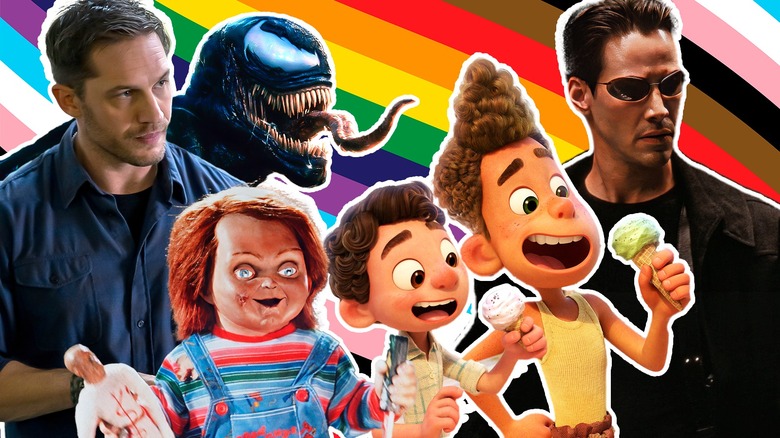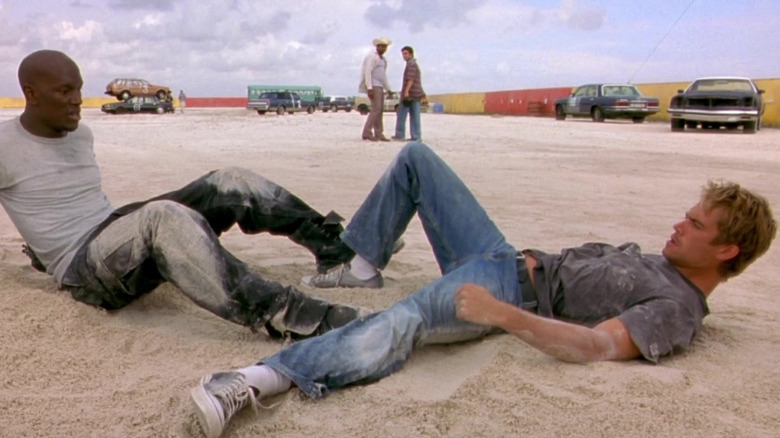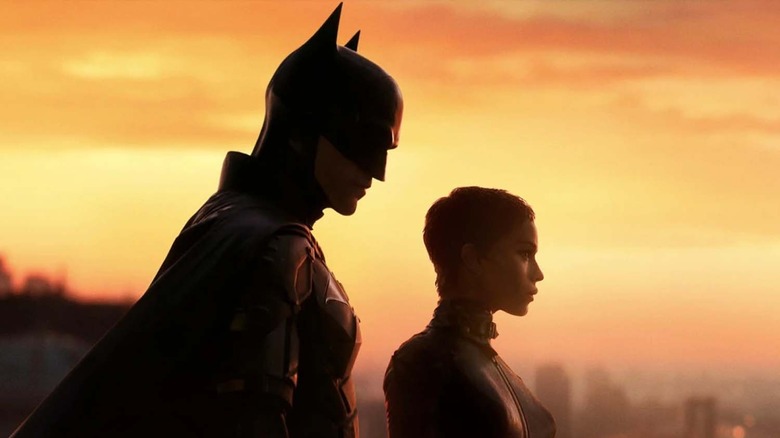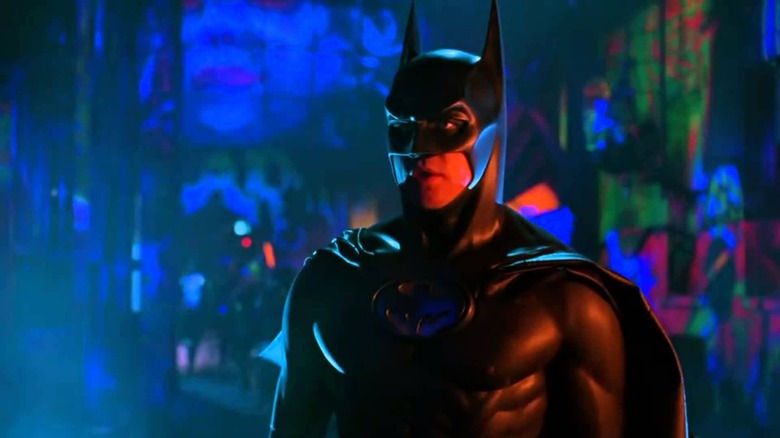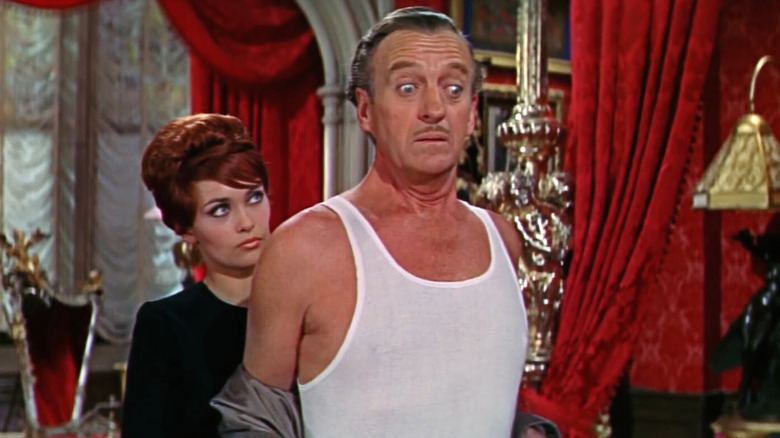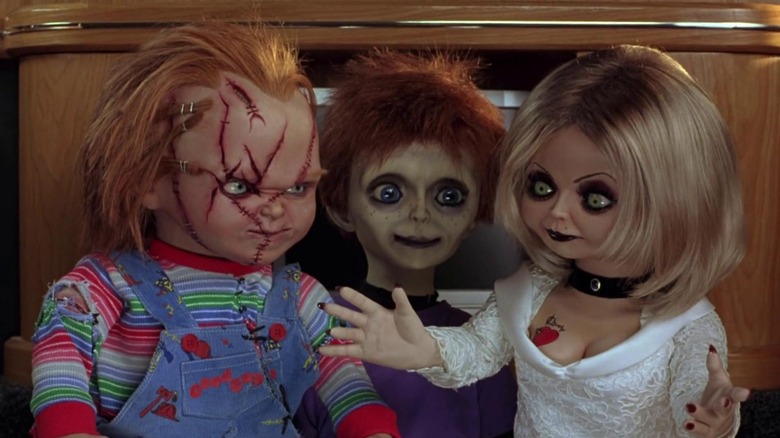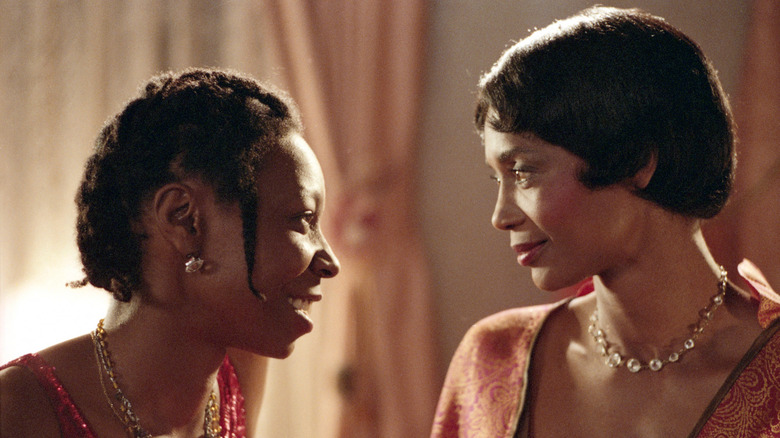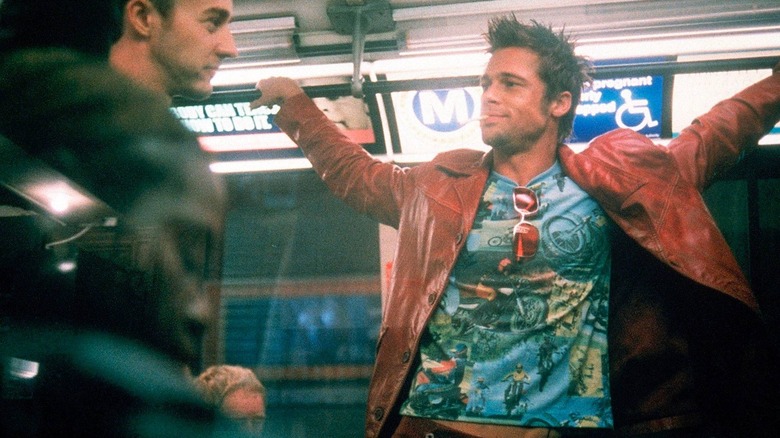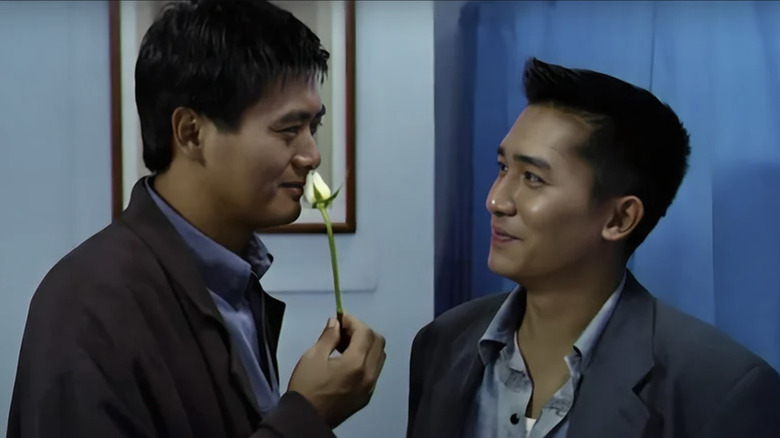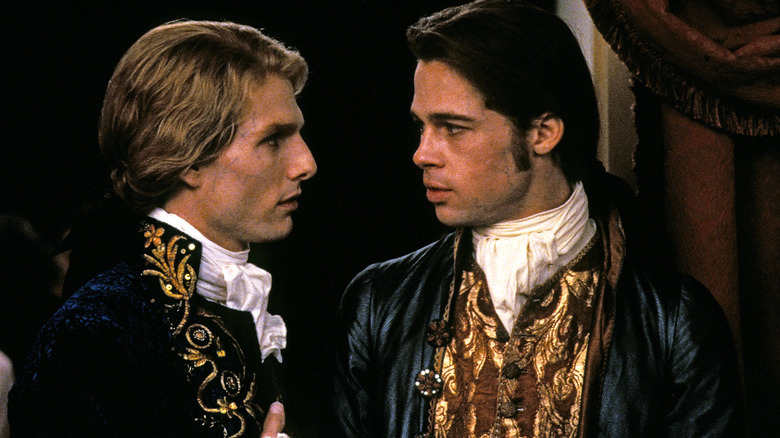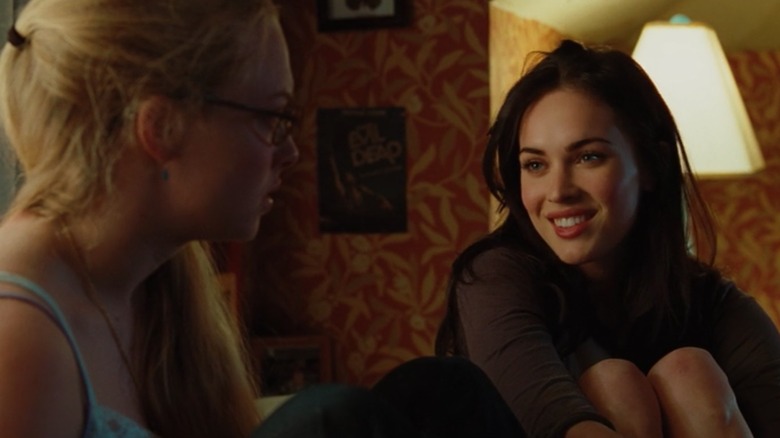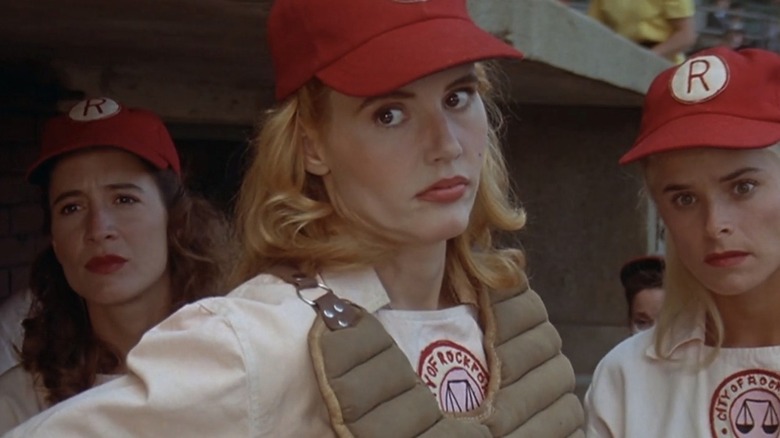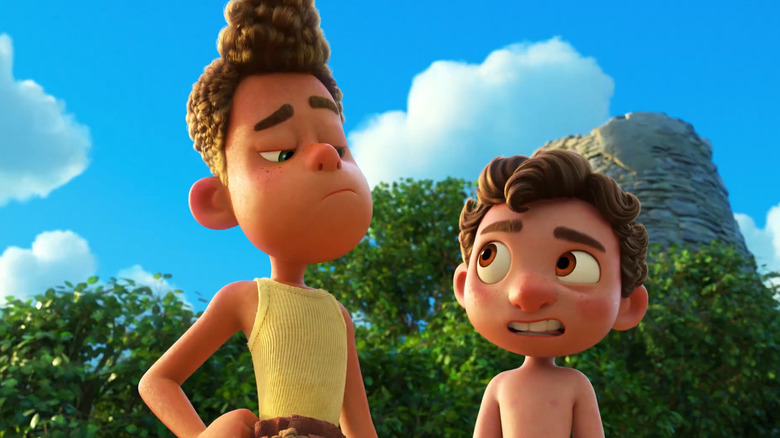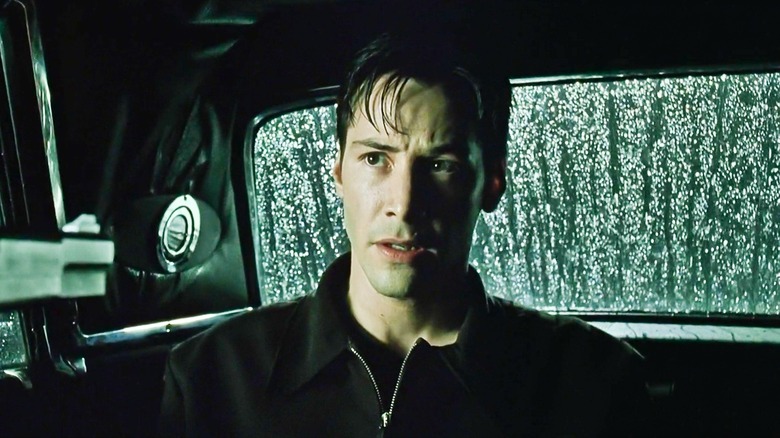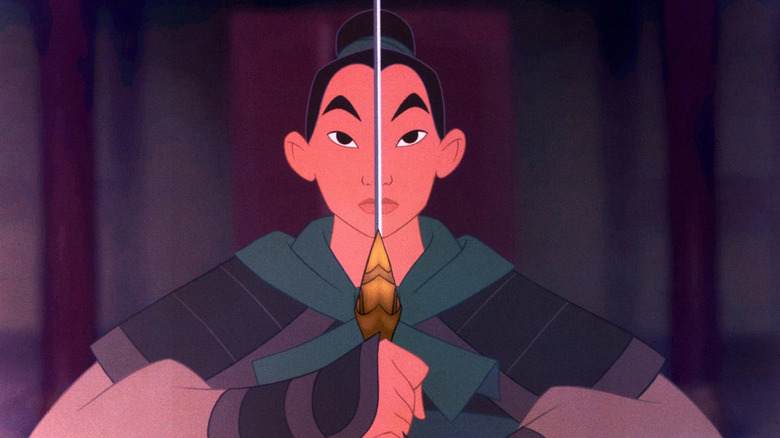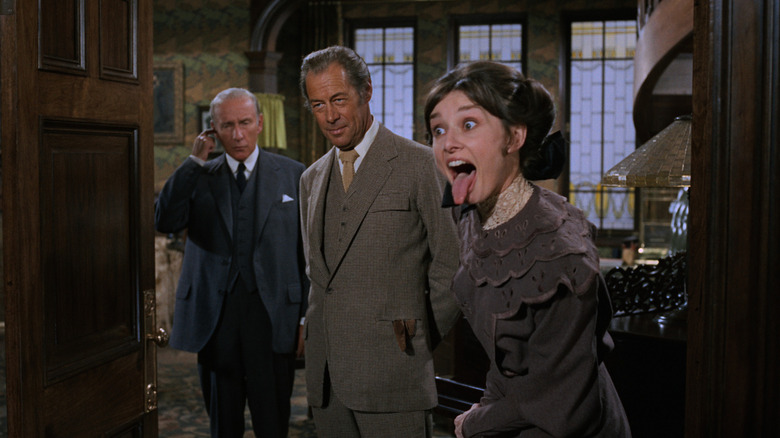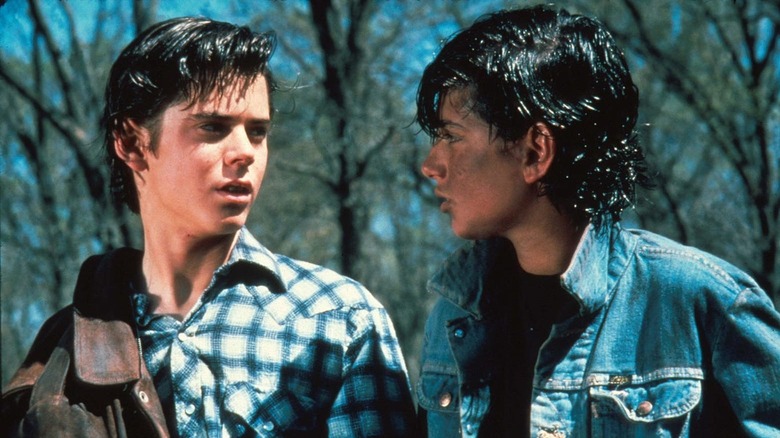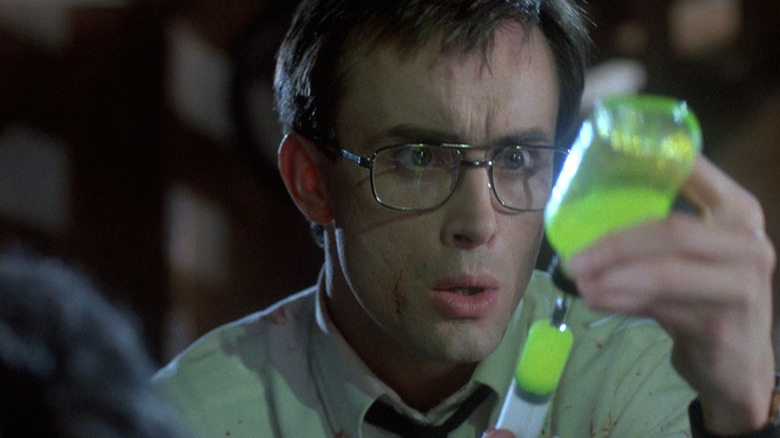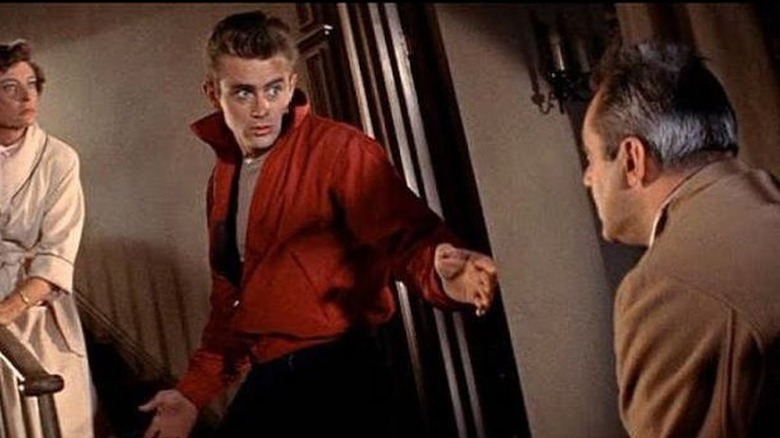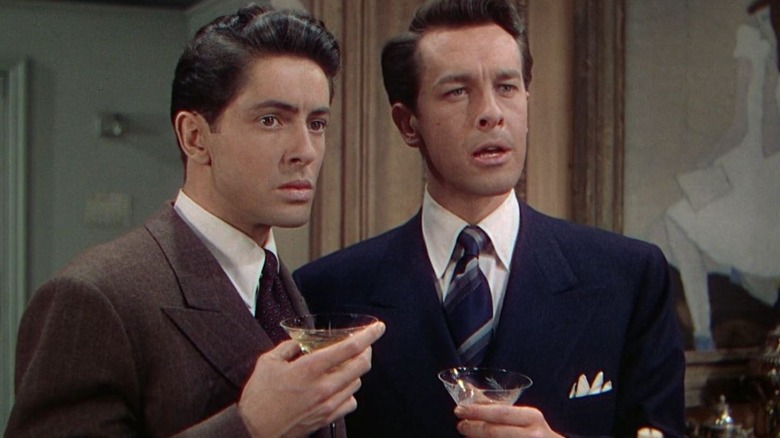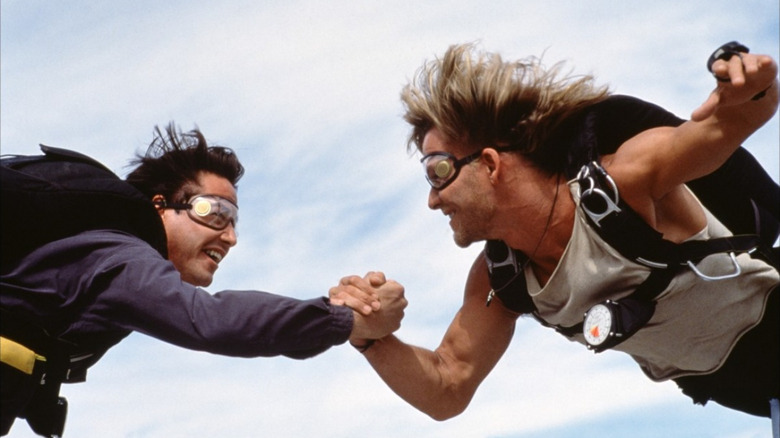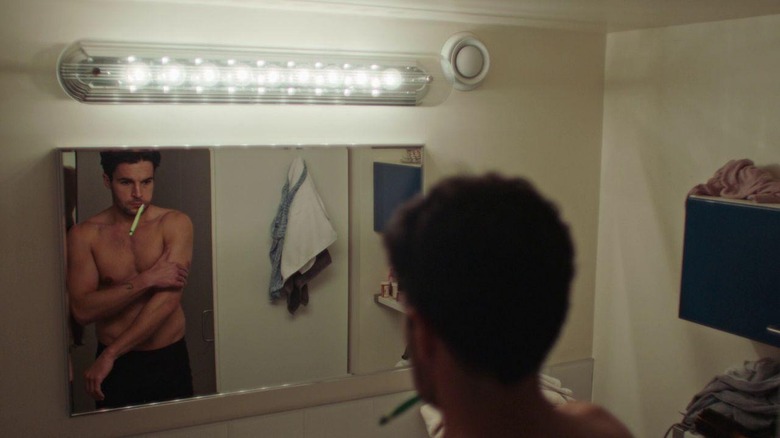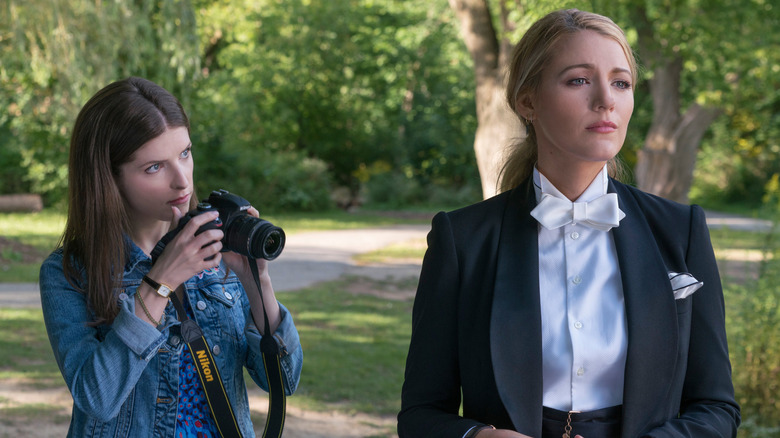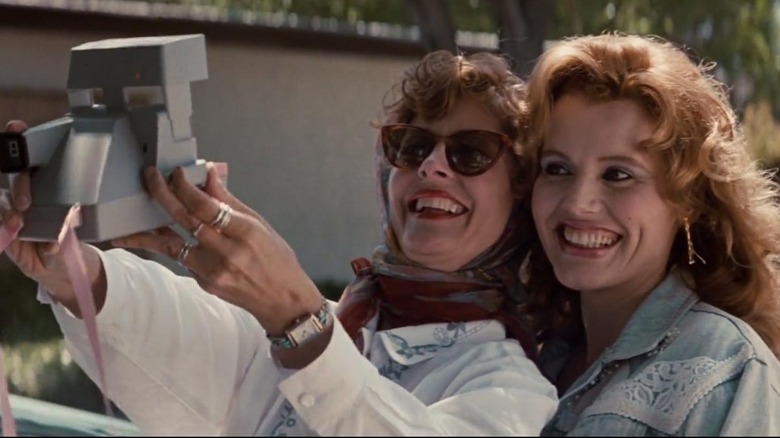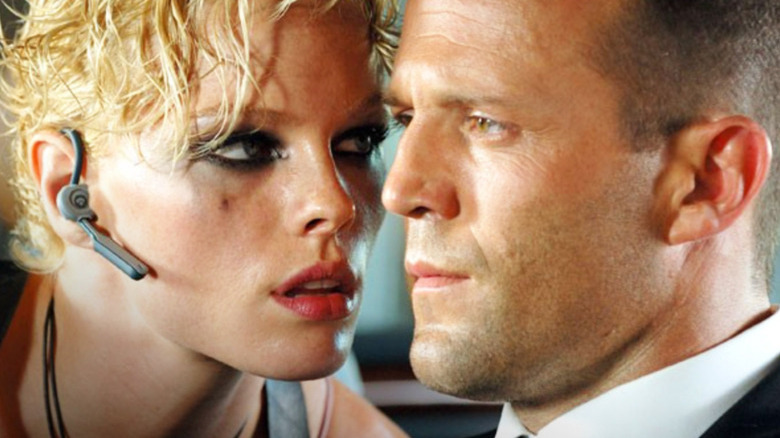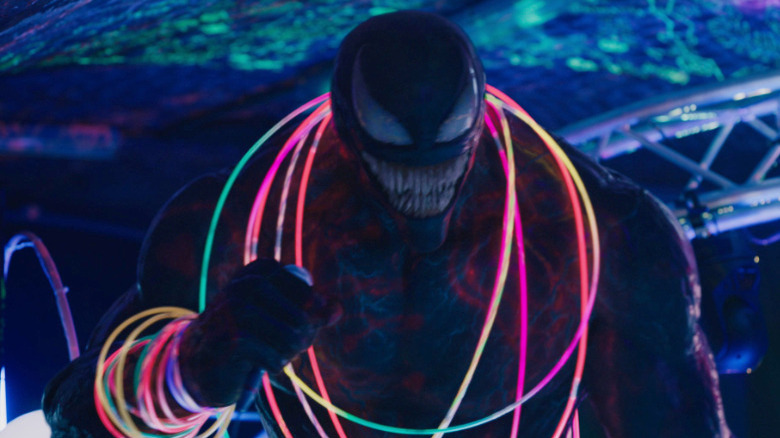The 26 Greatest Queer Movies You Didn't Realize Were Queer
The whole point of Pride Month is that LGBTQIA+ folks have a publicly acknowledged window in which they can loudly and proudly honor their history, and celebrate themselves, their community, and their identities. But not all queer folks have that luxury. Many people have to hide their true selves, either because it's the only way they can remain safe or because they're simply not ready to come out to the world yet. And while there are plenty of queer movies out there, especially in the underground and independent scenes, cinema has largely existed in the closet. Most movies can only be gay in secret, slyly revealing non-heteronormative intentions via sly lines of dialogue and subtext intended for a certain audience (if you know, you know).
So it's time to celebrate those movies. The queer movies that aren't always so explicit about their queerness, the LGBTQIA+ movies that are peeking out from the closet. Some of them are fully aware of their identities, and are just playing coy. Others are just so clearly gay, but haven't come to terms with it yet. But if you're programming a Pride Month marathon, you can't go wrong with these delicious, funny, scary, moving, ridiculous, and powerful films.
Happy Pride. Go watch a queer movie. Start with these.
2 Fast 2 Furious is a masculine love story
The "Fast and Furious" movies are all about machismo and emotional bonding, but John Singleton's often under-appreciated "2 Fast 2 Furious" is the one where the subtext flies off the screen. The film stars Paul Walker as Brian, an ex-cop who's in trouble for letting the criminal he bonded with in the first film go, and who must once again go undercover as a street racer to clear his record.
This time he's teaming up with Roman (Tyrese Gibson), who turns out to be the very reason why Brian has such powerful relationships with troubled men, and is willing to risk everything for them. Roman blames Brian for his own arrest, and now Brian is ready to make amends. So they scuffle on the ground, they bicker about blouses, and they run into more trouble when Brian starts falling for another undercover agent, Monica (Eva Mendez). Roman spends the majority of the film chastising Brian for being romantically interested in women, and shows nearly no interest in them himself.
To watch "2 Fast 2 Furious" is to watch a bromance with the letter "b" only barely visible. Singleton's approach to male intimacy is more intimate than the other filmmakers in the "Fast" saga, building meaningful bonds via queer energy, even if the characters never explicitly admit to their feelings. (William Bibbiani)
The Batman is a romance between a bisexual woman and an asexual man
The word "bisexual" is never used in Matt Reeves' "The Batman," nor does Selina Kyle (Zoë Kravitz) ever refer to her girlfriend Annika as anything other than her "roommate" (sigh), but Selina's panicked need to rescue Annika from the clutches of Gotham City's gangsters is too intense to be written off as a friendship. In the original DC comics, Selina, aka Catwoman, is canonically bisexual, so it would have been nice if Selina had said out loud that Annika was her proper, romantic lover. Even without it, however, Selina is clearly bisexual.
She is also attracted to Bruce Wayne (Robert Pattinson), aka Batman, a gloomy crime-fighter who doesn't seem very good at interacting with other human beings. It's not just that Batman is emotionally distant or wounded — a certain degree of emotional trauma is a traditional part of the conventional Batman origin story — he may also be aromatic/asexual. Batman expresses no interest in women, sex, or anything other than fulfilling his goals. He only bonds with Catwoman when it comes to getting the job done. He is single-minded and unromantic in a way that implies romance is simply not on his radar.
A lot of modern filmmakers have striven to keep their blockbusters safely within the confines of a PG-13 rating. This typically means that there will be no sex scenes or direct sexual suggestions. The stories of PG-13 movies rob heroes of any sexuality. They are too busy to bone. While the sex-related self-censorship may fulfill an unspoken four-quadrant-pleasing mandate, it also unwittingly created numerous examples of asexual representation. Aro/ace people will likely see themselves in the sexless heroes on the big screen. (Witney Seibold)
Batman Forever is a bisexual superhero dream
"Batman Forever" is a perfect bisexual allegory, forcing Bruce Wayne (Val Kilmer) to reconcile his queer desires (represented by Chris O'Donnell's Robin) and his straight ones (represented by Nicole Kidman's Chase Meridian), while also trying to adjust to being both Bruce and Batman. There's a whole lot of queer subtext going on, despite director Joel Schumacher denying that there's anything going on between Batman and Robin. Sometimes themes and subtext are completely unintentional, and that may be the case here, because "Batman Forever" is deliciously queer. It's a bisexual paradise, with gorgeous men and women all over the place, dressed in their camp finest. Drew Barrymore dressed like an angelic Marilyn Monroe? Debi Mazar in divinely drag-inspired devil gear? Kidman as a highly sexualized psychotherapist? O'Donnell and Kilmer in rubber suits with nipples? I'll have one of everything, please.
In the film's big climax, Batman ends up deciding that he can have it all, combining his worlds by being with both Meridian and Robin, allowing himself to be both Bruce and Batman without it driving him insane. The following film, "Batman & Robin," takes the camp up another level and is even more full of queer allegory, but "Batman Forever" will always be my bisexual superhero movie of choice. (Danielle Ryan)
Bend It Like Beckham is chapstick lesbian perfection
Gurinder Chadha's "Bend it Like Beckham" powerfully portrays the coming-of-age experience of the youngest daughter of British Indian Punjabi Sikhs and includes a takedown of the traditional gender roles expected of young women. Now viewed as a feminist teen classic, it's also undeniably sapphic. Jesminder "Jess" Bhamra (Parminder Nagra) and Jules Paxton (Keira Knightley) might be the definition of "just gals bein' pals," because when historians unearth this film in 100 years, they're sure as hell not going to buy them being anything less than in love.
When people mistakenly think Jess and Jules kissed at a bus stop (while also mistaking Jules for a man), Jess responds with "Kissing. Me? A boy? You're mad, you're all bloody mad," which is exactly the way a straight girl talks about smoochin' dudes. (I'm being sarcastic, obviously.) And if that wasn't gay enough, "Bend it Like Beckham" features multiple songs from Mel C. on the soundtrack. That's right, Sporty Spice, the patron saint of baby butches around the globe, is the featured musical stylings of the teen girl soccer movie.
Jules was right when she said "Just because I wear trackies and play sports does not make me a lesbian," because Jules would be a lesbian no matter what she wore or was interested in. Jess and love interest Joe may kiss at the airport at the end of the film, but Jess goes to America to play soccer with Jules, where I can only predict they finally stopped kidding themselves and admitted that they were meant to be together. (BJ Colangelo)
Casino Royale is the ultimate asexual spy adventure
To hear some James Bond fans tell it, certain installments in this franchise just don't count. Even a film like 1967's "Casino Royale," which is an official adaptation of the novel, is usually dismissed because it's not part of the Eon Productions series, and because it's got a satirical approach to the character and the series. But it's not as if the other, "official" James Bond films don't play fast and loose with canon, or ignore it altogether. And several Eon films are almost as silly as "Casino Royale."
What really seems to set this misunderstood classic apart is its approach to Bond's extremely heterosexual universe, where heroism goes hand-in-hand with virility, creating a hormonal power fantasy where violence and sexual conquest are glorified. In "Casino Royale," however, the plot revolves around all the spies in the world getting killed because they won't stop having sex. Once their pants are down they're easy marks for their enemies.
The clever conceit of "Casino Royale" is that in a hypersexualized criminal underworld, an asexual hero is unstoppable. So it goes that David Niven, playing against type, stars as a version of Bond that's disinterested in sex, and has to train a new series of agents to follow suit. Sex is kryptonite, asexuality is a superpower, and so begins a proper dismantling of every heterosexual action trope we usually take for granted (but definitely shouldn't). It's funny, subversive, and proudly ace. (William Bibbiani)
The Child's Play Series has more LGBTQIA+ representation than a pride parade
Don Mancini is the only horror creative in history to provide the screenplay for every installment of a slasher franchise and is also the only one to have canonically queer and trans characters while doing it. The first three "Chucky" films were released at a time when explicit queerness was a lot harder to show on screen, but Mancini brilliantly found ways to speak to the LGBTQIA+ experience through subtext.
Andy Barclay's greatest companion is a male doll that he sleeps with every night that quickly tries to ruin his life, and will do anything to gain his approval. If that's not a Baby Gay origin story, I don't know what is. Chucky's biggest scene in "Child's Play II" happens after hiding in a closet as Andy takes up refuge with his masculine-named sister, Kyle. "Child's Play III"? Well, ol' Andy has to go to military school to learn how to be a man, don't ya know? The whole film plays out like an allegory for conversion therapy camps.
Everything about the "Child's Play" franchise has been queer from the very beginning, but as time has gone on, the property has only gotten gayer, campier, and more inclusive. Between the introduction of Glen/Glenda — the non-binary child of killer dolls Chucky and Tiffany — and just about everything Mancini has ever asked actress Jennifer Tilly to do on screen, "Child's Play" has something for everyone under the rainbow. (BJ Colangelo)
The Color Purple is a story of Black queer love and survival
It's honestly a little perplexing that Steven Spielberg's "The Color Purple" doesn't universally register as a queer film. It's based on a famously queer novel that landed its author, Alice Walker, a Pulitzer Prize for Pete's sake! Yet, even one of the would-be stars of the "Color Purple" stage musical somehow missed the memo.
Celie, played wonderfully by Whoopi Goldberg in Spielberg's film, is a Black woman in the early 20th-century South. She is reticent and reserved from years of abuse at the hands of men, including her "husband," whom Celie calls "Mister." In time, though, Celie comes to experience romantic love thanks to Mister's outspoken mistress Shug.
Where Walker makes this relationship explicitly sexual, Spielberg restricts the story's queerness to subtext. His film shows Celie adoring a photo of Shug (Margaret Avery, also first-rate) before nursing her back to health. After the pair grow closer, Celie tells Shug her sex with Mister is deeply impersonal and unsatisfying. Shug responds with genuine affection before kissing Celie, at which point the camera pans away. Surely we all know what that means?
Spielberg has acknowledged he was overly "timid" in his handling of Celie and Shug's love story. "I was just a little embarrassed," he confessed in the documentary "Spielberg," in which his film is not unfairly accused of, essentially, Disney-fying its far grittier source material. But despite its shortcomings, "The Color Purple" remains a deeply moving and meaningful story of Black queer love and survival. (Sandy Schaefer)
Fight Club is full of queer language
"Three pitchers of beer, and you still can't ask. Cut the foreplay and just ask me. No one's watching, what do you care?" Is Tyler Durden (Brad Pitt) asking the film's narrator (Edward Norton) if he wants to fight, or if he wants to have sex?
David Fincher's 1999 film "Fight Club" might be one of the most salient criticisms of toxic masculinity to come out of its decade. "Fight Club" looked at a world where males had, after a generation of being "tough," lost their ability to express emotions openly. The narrator could only cry and achieve emotional catharsis by attending self-help groups, feeding off the mourning of others. He also cannot sleep. Something is unfulfilled in his psyche.
Into his life comes Tyler, a sexy, devil-may-care rebel who offers him a way to bond with other men: physical violence. The men achieve a new, ultra-masculine catharsis by pounding each other in the faces. This kind of physical contact between men is, of course, a substitute for the sexual touch and romantic tenderness they crave. They are so alienated from their emotions, heterosexual fistfights have to stand in for homosexual passion. There are, "Fight Club" asserts, few things gayer than striving toward heteronomative masculinity. And the dialogue is rife with subtext. When looking at the women in his life, a character idly ponders "I'm wondering if another woman is really the answer we need." Perhaps, he might say next, he needs a man in his life. A father figure ... and lover?
"Fight Club" ends with a shot of a penis, a symbol of Tyler Durden's impish sexuality, appearing moments after his ostensible destruction. He lives on, the film says. His aggressive, queer energy is still a part of the narrator. (Witney Seibold)
Hard Boiled is MLM love with a bullet
John Woo is a master of practical violence, the master of gun-fu, and inarguably one of the greatest action film directors to ever do it. He's also a man who understands the importance of intimate storytelling between men, and often unintentionally invites beautifully romantic gay reads of his films. His magnum opus, "Hard Boiled" is a high-octane shoot-'em-up boasting scenes so action-packed that your eyeballs might melt out of your skull, but it's also a gentle examination of how, as I referred to it in my piece titled "Hard Boiled" is Gay, "macho posturing takes the place of vulnerability in masculine spaces."
The film stars Chow Yun-fat and Tony Leung, China's answer to Robert De Niro and Al Pacino, respectively. In the midst of exquisitely choreographed bullet ballet are these two men, dripping with passion, chemistry, intensity, and love. Of course, showcasing any bit of softness — which is equated with vulnerability or *gasp* femininity — cannot exist in this world, so the duo is destined to express how they feel with more violent, aggressive actions.
Oh, and the Big Bad of the film at one point holds Chow Yun-fat at gunpoint and tells him to take his pants off and tell everyone that he's impotent in an act of public humiliation. Why? Well, if you've seen "Succession," you know what I'm saying. (BJ Colangelo)
Interview with the Vampire is an immortal gay romance
We lost one of the 20th century's most unique, prolific, shamelessly pulpy, and vocally pro-LGBTQ writers just over a year ago, and many are still mourning the loss of the inimitable Anne Rice. Though she wrote everything from erotic fiction, Christian fiction, historical novels, and memoir, Rice is best remembered for her 13-book Vampire Chronicles series. The first, 1976's "Interview with the Vampire," has lived just about as many afterlives as its iconic central vampire, Lestat. And every one of them is gloriously gay.
The terribly underrated maestro of queer sleaze, Neil Jordan, tapped the novel for a glossy, big-budget adaptation in 1994. One thing that is incredible about Rice's novel is how manifest the queer subtext is. It is in fact simply just text: The centuries-old vampire impresario Lestat falls deeply in love with his tempestuous protege Louis, and Louis falls deeply in love with the French vampire coven leader Armand. Even more incredible is the fact that Jordan sustained the romantic and sexual nature of these relationships in his film, which went on to gross four times its budget, receive two Academy Award nominations, and see Tom Cruise, Brad Pitt, and Antonio Banderas play the members of its vampiric love triangle.
In a 2017 interview with The Daily Beast, Rice said, "People told me 'Interview With the Vampire' was a gay allegory, and I was very honored by that." Continuing, "I think I have a gay sensibility and I feel like I'm gay, because I've always transcended gender, and I've always seen love as transcending gender." Amen. And Rice's work — and Jordan's film — transcend time. (Ryan Coleman)
Bisexual sandbox love never dies in Jennifer's Body
I've written about and spoken at length about Karyn Kusama's brilliant "Jennifer's Body" and the way it was unfairly maligned by critics and audiences alike for not fulfilling the marketing campaign's promise of "Megan Fox goes girl-on-girl," and I won't stop until people understand that this horror-comedy was never meant to appease cis straight men. No, to quote Melanie Lynskey in the most recent season of "Yellowjackets," this film is "for goths and bisexuals." Jennifer (Fox) and her best friend Needy (Amanda Seyfried) have a toxic, co-dependent friendship that dates back to being toddlers in the sandbox. They're best friends, yes, but their connection is one that goes beyond platonic limitations. There's genuine, sincere affection, and when the two share a kiss on Needy's bed, it's the cumulation of a film littered with sexual tension.
When Needy calls out Jennifer for killing people, she famously snaps back, "No, I'm killing boys." It's a joke that plays into a line I've heard so many of my bisexual friends parrot before, "I'm attracted to every woman and like one guy." Sure, that's a little reductive as far as the definition of bisexuality is concerned, but it's also the type of humor that only other queer people are going to fully understand. And that's the magic of "Jennifer's Body." It's a film speaking a language that straight men aren't fluent in, which is why the film's later-in-life reclamation was shepherded by the girls and the gays. (BJ Colangelo)
A League of Their Own has always been queer
There's no crying in baseball, but there are a lot of hot lesbians. At this point, if you don't understand the queerness of "A League of Their Own," you've either never interacted with a sapphic person in your life or you're willfully playing dumb. The beloved film was recently given a (canceled too soon) series adaptation that put the queer history on front street, but the implicit queerness of the film about the All-American Girls' Professional Baseball League cannot be separated because it's embedded in the story's history. Despite Rose O'Donnell being told "Don't do it so gay" while playing Doris, it's impossible to tell a story about queer history and erase the queerness. The script of Penny Marshall's 1992 film might not explicitly call it out, but it's undeniable that "A League of Their Own" is and has always been a queer text.
It was dangerous to be out in 1992 and had the film been true to the history of the Rockford Peaches, it's doubtful that the film would have ever been given the financing to come to fruition. After all, "A League of Their Own" is a story of queer triumph, not trauma, and mainstream Hollywood certainly had no interest in letting lesbians exist on screen unless for the fetishistic gaze of cis straight men or as tragedy porn fodder at the time. Fortunately, the new series took the subtext of the original and made it canonical, honoring queer history in the process. (BJ Colangelo)
Luca is a joyous queer coming-of-age romance
Just the premise for "Luca" alone earned it the nickname "Pixar's 'Call Me By Your Name'" well before its release. A coming-of-age summer story about two boys and their relationship set against a scenic Italian backdrop? There hadn't been a Pixar movie that sounded so inherently queer since the one about the archery-loving, red-haired Scottish lesbian.
Set in the '50s, "Luca" follows timid adolescent sea monster Luca (Jacob Tremblay) and his newfound adventurous companion/fellow aquatic creature Alberto (Jack Dylan Grazer) as they try to win enough money to buy their own Vespa. In the film's fantasy setting, sea monsters appear to be humans out of the water, allowing Luca and Alberto to pass for two young boys as they spend their summer in the coastal Italian town of Portorosso.
The "passing" conceit in "Luca" is absolutely flexible, yet it truly works wonders as a metaphor for being queer. Add the fact that Luca's fear of being "outed" as a sea monster while on land drives much of the plot, and it becomes even clearer just how effective "Luca" is as a figurative portrayal of queer identity. Luca and Alberto's relationship with the queer-coded young Italian girl Giulia (Emma Berman) only further enriches this subtext while also doubling as a touching depiction of queer friendship. It's why, despite the absence of an unmistakably queer romance, "Luca" makes for a joyous and otherwise better LGBTQIA+ story than all of Disney's "first" queer movie moments combined. (Sandy Schaefer)
The Matrix is a cyberpunk trans allegory
"The Matrix" was always an audacious trans allegory, although it understandably took some time for the world to recognize this. Lilly Wachowski has candidly admitted that she and her sister Lana broached the film's message of "transformation" from a "closeted" place, having directed their trailblazing cyberpunk action flick years before either of them came out as trans. But just because the film doesn't announce its queer themes loudly and proudly like the Wachowskis' later mind-bending works, that doesn't mean you can't sense the subtext. It's almost like it's ... a splinter in your mind, driving you mad.
Consider our protagonist Neo (Keanu Reeves). His nemesis, Agent Smith (Hugo Weaving), is a shades-sporting sentient program who delights in basically dead-naming Neo, referring to him as "Mr. Anderson" with the same sneering energy as human clown car Ted Cruz snickering about his "pronouns." The very notion of "Mr. Anderson" is a literal construct Neo can only escape by accepting a red pill, recalling the estrogen pills that trans women and transfeminine people take as part of their hormone replacement therapy (HRT) treatment. Once he does, his physical body is then medically transformed, allowing him to fully actualize his authentic self separate from the "mental projection of [his] digital self" The Matrix assigned to him at birth.
Early "Matrix" screenplay drafts made this trans allegory all the more obvious — and yet, even without that, one cannot overlook the Wachowskis' still all-too-radical queer metaphor today. (Sandy Schaefer)
Mulan made a man out of me
In 1998, I was a rambunctious 11-year-old tomboy who had spent her entire young life struggling against the bonds of femininity. I remember seeing "Mulan" in theaters, followed by chicken nuggets at the food court. Not since I first saw Princess Leia tell Luke and Han that somebody has to save their skins in "Star Wars" did I feel such inspiration. I wanted to be Mulan, or Ping, or both (voiced by Ming-Na Wen). I identified with Mulan's failures at the tea ceremony where she's supposed to impress the matchmaker, just like I identified with her feeling camaraderie among "the guys" when she joins the army. "I'll Make a Man Out of You" hit hard because it made me feel like maybe, with enough hard work, I could be a man too.
"Mulan" isn't just a brilliant way for young people to understand the flexibility of gender and maybe find gender euphoria for themselves, it also features Disney's first bisexual prince, Li Shang (BD Wong). It's pretty clear that he's into Mulan when she's Ping and doesn't know how to address it, but he's attracted to her as Mulan, too. I may not have ever gotten to have a talking dragon voiced by Eddie Murphy to help me with things, but "Mulan" helped me process gender at an early age and I'm forever grateful. (Danielle Ryan)
My Fair Lady is a fascinating work of queer coding
This isn't a universal truism, but generally, the further you go back in Hollywood history, the more complex, subtextual, and symbolic the queer readings become. On its face, the classic Broadways musical adaptation of "My Fair Lady" is as straight as they come. Read heterosexually, the story of an intolerant, withholding older man (Rex Harrison) systematically breaking down a naïve, happy-go-lucky young woman (Audrey Hepburn) and building her back up into the kind of woman he prefers is actually insidious, a story as old as misogyny itself. But "My Fair Lady" is such a strange, deep, and self-conflicted work, that it's virtually impossible to take seriously on its face.
From the jump the production was rainbow-spangled: its director, George Cukor, was the greatest gay film director who ever lived; many believed the play's original author, George Bernard Shaw, was a "repressed homosexual"; star Audrey Hepburn had already appeared in one of the most stunning, explicitly queer films of the post-studio era, "The Children's Hour"; co-star Rex Harrison would go on to star in another, "Staircase."
Harrison is at the center of the film's queer reading, though it's Hepburn who steals every scene. As is made perfectly clear in a new song that was written for the film, "Why Can't A Woman Be More Like A Man?," Harrison's Henry Higgins, who "lusts" after Hepburn's Eliza Doolittle but lives with a man (Stanley Holloway), seems like he'd much rather simply date that man than laboriously break Eliza down and rebuild her. This is what makes "My Fair Lady" such a fascinating document of the conflicting sexual mores of its time: it's as flagrantly homoerotic as it is misogynistic, and the two, both located in Higgins, are inextricable from one another. (Ryan Coleman)
The Outsiders is a powerful tribute to male romance
The relationship that queer people have with certain formative texts that shape our sensibilities is not always shared by the actual authors of those texts. A textbook example is "The Outsiders," S.E. Hinton's classic, coming-of-age novel about the bonds between down-and-out boys in post-war Oklahoma that was brilliantly adapted into a 1983 film by Francis Ford Coppola.
"The Outsiders" has inspired young queer readers for decades, as it's become a staple text in high school curricula. The fiery, romantic tale of Tulsa Greasers Ponyboy, Johnny, and Dally (portrayed passionately in the film by C. Thomas Howell, Ralph Macchio, and a never-dreamier Matt Dillon) evading the law, struggling to fit in, and fighting the world for each others' love reads to many like capital-r Romance. But Hinton didn't agree.
In response to fans inquiring whether the outsiders of "The Outsiders" could possibly be read as gay on Twitter in 2016, Hinton herself declared in unambiguous terms: "No, they are not gay. I wrote them, I ought to know." Well, that settles it. Right?
Not quite. Personally, I've never read "The Outsiders" as a gay story, even if the connections between Pony, Johnny, and Dally are so intense at times they make one blush. My reading of the Coppola film in particular, which really teases out the sweetness and subtleties between Hinton's characters, is that it is a paean to male romance. The story is riddled with what an academic might call "homosociality" — romantic energy that is not sexual, but not platonic either. Coppola created a world in which men can confide in each other, be true with one another, and love one another fiercely without fear or shame. That's something to be proud of. (Ryan Coleman)
Dorm room experiments in Re-Animator
The nervous, twitchy Herbert West (Jeffrey Combs) has just moved in with the studly, confident Dan (Bruce Abbott). They are both medical students at Miskatonic University. One night, Herbert, using an experimental re-agent, brings Dan's dead cat back to life. The undead cat is violent and terrifying. Dan has to kill it again. Herbert explains that his glowing green re-agent can indeed resurrect the dead, but that they turn into mindless, violent zombies. It's taboo, but extraordinary. Surreptitiously, Herbert offers to show Dan that his re-agent will work again. He injects the dead, mutilated cat once again, and it twitches back to life. They are both aghast, but fascinated. This ... this works. And it's amazing.
Then Dan's fiancée Megan (Barbara Crampton) walks in on the two men experimenting. She is horrified.
Substitute the injection of a dead cat with queer sexual experimentation, and the scene would play out the same, emotional-beat-for-emotional-beat. Herbert West is hardly an ultra-masculine presence that seems able of seducing Dan, but he is certainly coded queer, an outsider interested in new possibilities that the heteronormative romances around him do not provide.
"I will not be shackled by the failures of your God," Herbert declares in the sequel, "Bride of Re-Animator." This is an allusion to the "playing God" tropes from most Frankenstein-ian stories, but he also seeks humanity, relationships ... romances? ... outside of what American bigoted Christianity dictates. And Dan? Why does he continue to follow Herbert around? Why is he so fascinated? Surely the "influence" he has on Dan might have a sexual dimension. After all, it's a story of two men who bond over the experiments they conducted in their dorm together. (Witney Seibold)
Rebel Without a Cause burns with barely-coded homoerotic passion
There may never be another cast who so thrillingly captured the zeitgeist, representing when taken together the arrival of a new style of acting, indeed an entirely new Hollywood, than the cast of Nicholas Ray's "Rebel Without a Cause."
In 1955, The Method, as pioneered by Konstantin Stanislavski, was still working its way into the waters, the consent decrees that would cause the demise of the studio system had already hit Paramount Pictures, but hadn't fully taken effect yet, and likewise, the Hays Code, which bottlenecked what could be said and shown in studio films, had only just been overturned. It was the dawn of a new era, and "Rebel Without a Cause" became the decade's biggest test case in how far filmmakers could push audiences and studio execs alike.
The film starred epochal heartthrob James Dean as Jim, a rebel who honestly does eventually develop a cause, who's moved to a new town by his scared, disapproving parents so he can start over. But all he does is fall in love with vixen Judy (Natalie Wood) and become, uh, good friends with Plato (Sal Mineo). "Rebel" includes several scenes which open up ample space for a queer reading, such as a brief glimpse of a photo of Alan Ladd Plato has pinned up in his locker, or countless scenes in which Plato looks covetously on at Jim as he embraces Judy. In their making-of book on "Rebel," Lawrence Frascella and Al Weisel note that an early cut of the film actually included a scene in which Jim and Plato kiss. But even without it, "Rebel Without a Cause" holds up as a thrilling piece of mid-century queer coding. (Ryan Coleman)
Rope is Alfred Hitchcock's incredibly gay thriller
Alfred Hitchcock's 1948 film "Rope" is as queer as a studio movie of its period can be. Taking inspiration from the real-life murderers Nathan Leopold and Richard Loeb, "Rope" tells the story of two young men named Phillip (Farley Granger) and Brandon (John Dall) who, merely for an intellectual thrill, murder a classmate. They strangle their victim with a piece of rope and stuff his body in a wooden chest, all before some other friends come over for a dinner party. Hitchcock shot "Rope" to make it look as if it was all one, long continuous take, so we get to see the smugness of the murderers — as well as their panic — more or less in real-time. If they can get away with a "perfect murder," they will be irrefutably superior to the rest of society.
Although Phillip and Brandon don't ever explicitly mention a sexual or romantic dimension to their relationship — largely taboo in 1948 — their body language, intense friendship, and mutual understanding that they are superior outsiders all point to the possibility of them being engaged in a love affair. If they were forced to live in the closet by a bigoted society, then their murder would be understandable, if not justified. Why tolerate a world that doesn't tolerate us? Our queerness makes us superior. It's simultaneously twisted and empowering.
One needn't dig deep to find the queerness in "Rope." In the 1929 Patrick Hamilton play on which the film is based, Phillip and Brandon were indeed lovers. Arthur Laurents, the film's screenwriter, was a gay man, and Farley Granger was openly bisexual. John Dall was also rumored to be gay, although he never came out in his lifetime. (Witney Seibold)
Point Break takes bromance to another level
As a preteen just getting into a serious Keanu Reeves phase, I sought out Kathryn Bigelow's 1991 action flick "Point Break," a heist movie of sorts about an undercover FBI agent named Johnny Utah (Reeves) infiltrating a gang of bank robbers led by surfer dude Bodhi (Patrick Swayze). I remember being teased for even wanting to watch it, told that it was "super gay" in a derogatory way, which only made me want to see it more. I ended up loving the movie and found myself attracted to most of the leads (Reeves? Swayze? Lori Petty? I mean c'mon, it's a total bisexual smorgasbord), and couldn't understand why people wouldn't love this earnest, exciting movie.
/Film's Valerie Ettenhofer already gave the perfect breakdown of why "Point Break" is a queer masterpiece. It's a movie that can be read as just a deeply passionate friendship between two men or it can be unabashedly queer, though "I know you want me so bad, it's like acid in your mouth" is pretty hard to take as totally straight. So why did I get grief for this film but not the equally gay "Top Gun"? Maybe it's because the men in "Top Gun" are always in competition, their masculinity constantly reinforced as they hide their feelings, but "Point Break" lets its male leads be vulnerable with one another. That vulnerability makes "Point Break" extra emotionally resonant, and makes Utah's unwillingness to shoot Bodhi make all of the sense in the world. If that's not love, what is? (Danielle Ryan)
Brandon Cronenberg's Possessor is an unsettling trans metaphor
Brandon Cronenberg's "Possessor" is a brutally violent psychological horror film about personal identity, but it struck a chord with me as a non-binary person who has often longed to live in a different body. The film centers around Tasya Vos (Andrea Riseborough), an assassin who uses special technology to inhabit other people's bodies and use them as her instruments of death. When she first "wakes up" in the body of Colin (Christopher Abbott), she is clearly experiencing a kind of ecstasy. She runs her new hands over Colin's muscles, staring in the mirror and looking both confused and elated at the sensations. Every act she does as Colin gives her a kind of gender euphoria, a comfort she has never known because she felt trapped by her own physical limitations.
"Possessor" is a devastating tale about the masks we wear, pretending to be one person when in reality we're someone else entirely. For those who have no choice but to mask, like closeted trans people or folks who just haven't figured out their gender yet, Tasya's experience is oddly reassuring. Not all representation has to be positive, after all, and a little queer rage can be cathartic. (Danielle Ryan)
A Simple Favor is a farcical queer Hitchcockian meet-cute
What happens when a chipper single mom from the suburbs has a meet-cute with a chaotic bisexual femme fatale decked out in a suit worthy of the Met Gala? You get Paul Feig's farcical 2018 thriller "A Simple Favor." Anna Kendrick stars as a vlogger who befriends the debonair mother of her young son's classmate (Blake Lively), oblivious to the skeletons hanging next to the many finely-tailored outfits in her newfound bestie's closet. It's a deliciously offbeat tale of mystery and murder that's queer down to its bones, and not just because Kendrick and Lively lock lips at one point ... although there is that.
Unlike similar thrillers borne from the success of "Gone Girl," "A Simple Favor" is deeply weird in that uniquely queer sense. It's a movie where soapy plot twists are somehow played both earnestly and dripping with self-awareness, allowing Feig to suddenly toss in a broad slapstick gag at the drop of a hat. But it's Kendrick and Lively's sexually-charged cat-and-mouse game — one that evokes such queer-coded Alfred Hitchcock classics as "Strangers on a Train" — that really earns the film its LGBTQIA+ cred. The pair sip martinis, trade secrets, and swap clothes (both figuratively and literally) in what can only be summarized as an elaborate game of foreplay.
The only real issue is that "A Simple Favor" doesn't end with its leads fleeing the cops like they're Harley Quinn and Poison Ivy. Maybe the sequel can fix that. (Sandy Schaefer)
Thelma & Louise is a tragic sapphic romance
There are lots of movies out there about men who have had it with life for one reason or another and decide to go on a rampage, but what about women? Ridley Scott's 1991 classic "Thelma & Louise" follows Thelma (Geena Davis) and Louise (Susan Sarandon), two best friends who end up going on the road trip from hell together after Louise kills a man for attempting to rape Thelma. Along the way, Thelma snags herself a handsome young suitor (Brad Pitt), but the real romance is between the two traveling ladies. Their "straight" lives as wives in a patriarchal world weren't doing them any favors and they ended up choosing one another instead. As they embrace their own happiness and reject the lives they were given, they embrace one another as well. In the end, they choose each other and drive off a cliff with their hands clutched together instead of turning themselves into the police, which is kind of the cinematic equivalent of some newly-in-love lesbians driving off with their U-Haul in tow.
Thelma and Louise even share a little kiss before they die, though there were plenty of other options for the ending. Thankfully we got the best one, one that highlights the power of sapphic love even in the face of extraordinary challenges. I love these ladies. (Danielle Ryan)
The Transporter and Transporter 2 created a gay action icon
The first two "Transporter" movies star Jason Statham as Frank Martin, a getaway driver and all-around badass, whose code of ethics in a world of criminality repeatedly forces him to kick a lot of ass. And while both films are exceptional in the action department, there's something about Frank that the movie never comes out and says, but seems inescapable.
Frank isn't interested in the many sexy women in his orbit. He only has sex with the first film's "romantic" lead when she's extremely forceful, and afterward he starts wearing different, more buttoned up clothing, and she complains that he doesn't talk very much anymore. In "Transporter 2" when Frank's employer makes sexual advances, he refuses her, because of, quote, "Who I am."
The "Transporter" screenplays aren't comfortable saying it out loud but Frank is gay, and has more romantic chemistry with his cop cohort Tarconi (François Berléand) than any of his women co-stars. Louis Leterrier, who directed the second installment and co-directed the first, admitted as much in interviews, even calling Frank "the first gay action hero." Sadly, subsequent films in the series walked this aspect of Frank back as much as possible, even forcing him to prove he's heterosexual at gunpoint, in a particularly awful moment in the generally awful "Transporter 3."
At least we have the first two. They're some of the best action films of the 2000s, they're wonderfully queer-coded, and that grease fight is legendary. (William Bibbiani)
Venom: Let There Be Carnage is a superhero blockbuster about dueling pansexual polycules
A couple of films on this list nothwithstanding, there just hasn't been much queer representation in modern superhero movies. So you gotta give Sony's "Venom" movies credit for picking up a lot of that slack. Ruben Fleischer's first installment starred Tom Hardy as Eddie, a loner who forms a deeply intimate and confusing bond with an alien symbiote, and the queer-coding on their relationship was anything but subtle. But Andy Serkis's "Venom: Let There Be Carnage" took the series to new heights.
"Let There Be Carnage" isn't just the story of Venom, it's the story of Venom's polycule, with Tom Hardy trying to juggle his romantic feelings for both his ex, Anne (Michelle Williams), and his new live-in partner, Venom. Anne has also merged with Venom and admits that it's a sexual thrill, and Venom cares about Eddie's feelings for Anne, even though her fiancé Dan (Reid Scott) isn't entirely comfortable with the arrangement at first. Dan doesn't get it and he's a little jealous, but he's supportive and a good ally on multiple levels by the end of the film.
The plot of "Let There Be Carnage" finds another symbiote forming a new polycule with serial killer Cletus Kasady (Woody Harrelson) and his girlfriend Frances (Naomie Harris), but their undoing isn't their evil plans, it's their jealousy and in-fighting. Our heroes save the day by being respectful, responsible, polyamorous and queer. The Avengers, sadly, would never. (William Bibbiani)
